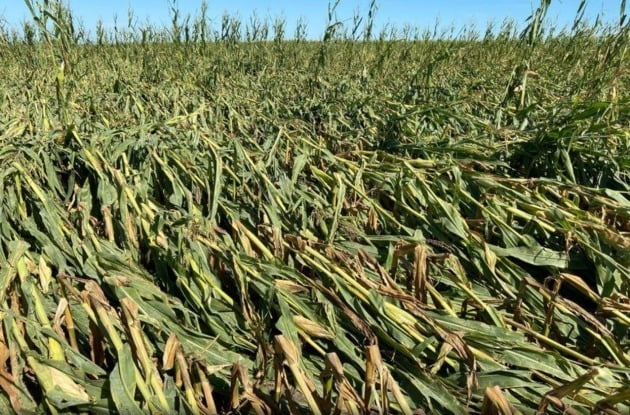
Cornfields in Iowa, USA suffered from storm damage following last year’s drought.. Reuters Yonhap News
The government decided to temporarily abolish tariffs on imported corn. This is because the recent rise in international grain prices is putting a burden on inflation. It also decided to cut the interest rate on loans to purchase raw materials for food and to significantly increase the amount of egg imports.
Corn tariff 3 → 0%
According to the Ministry of Agriculture, Food and Rural Affairs on the 7th, the government decided to lower the import tariff on edible corn from 3% to 0% by the end of the year. It is now possible to import up to 1.28 million tons without tariff.
Imported corn is used as a raw material for starch and starch sugar in Korea. Of the 821,000 tonnes of starch and starch sugar, 69% is made from corn. It is widely used as a raw material for food such as confectionery, bakery, beverage, starch syrup, liquor, and non-food such as paper and cardboard.
The government previously explained that it has decided to eliminate tariffs on soybean meal and feed corn, and then to remove tariffs on edible corn. In the case of other grains such as glutinous rice and sesame, he said it is not considering a tariff cut.
The reason why the government has eliminated corn tariffs is because international corn prices are soaring this year. According to Investing.com, the US corn futures price has risen 57.75% over the past year. According to Agrisos, an agricultural forecasting agency in the United States, there is a possibility that the price per bushel (27.2kg) of corn, which exceeded 5 dollars earlier this year, will jump to 7-8 dollars in the summer. Experts say that last year’s drought and typhoon had a direct impact in Iowa, one of the representative grain areas in the United States.
Grain prices rise because of Chinese pigs?

Photo = Yonhap News
It is analyzed that the influence of China is also large. It is pointed out that international grain prices are rising due to a surge in demand for corn in China.
China uses corn a lot for pig feed. Pork is a key ingredient used in most Chinese cuisine. However, due to the African swine fever (ASF) that hit China in 2018, the amount of pigs raised has decreased significantly. Corn demand also declined. Then, the Chinese government removed the system that guarantees the lowest price for corn farms. Corn farms in China have naturally started to cut production.
However, things have changed since last year. When the ASF subsided, the amount of pigs raised again increased significantly, and accordingly, the demand for feed also increased. With insufficient domestic production base, China has begun to significantly increase corn imports. In February, it also signed the largest import contract ever.
Experts predict that the price of imported corn will continue to rise until China’s own production returns again.
It is often found that international prices fluctuate according to the current state of the food supply in China. In 2013, as the consumption of beef in China increased, the price of international beef rose significantly.
Lower interest rates for grain import funds
On this day, the government introduced a plan to reduce tariffs and improve various systems related to inflation. Since the 8th of last month, the import procedure has been improved and implemented, such as collecting on-board specimens and issuing an import declaration certificate first for rapid customs clearance of international grains, which was a request for the domestic food industry.
Previously, samples were collected after unloading after entering the port, but now they are unloading after collection and inspection.
In order to ease the cost burden in the industry, the interest rate for the purchase of raw materials for food is also cut. The interest rate for feed companies’ raw material purchase funds and food service comprehensive fund will be lowered from 2.5 to 3.0% to 2.0 to 2.5%.
The government also upgraded the’International Grain Advisory Committee’ to the’International Grain Supply and Demand Countermeasure Committee.’ An official from the Ministry of Agriculture and Food said, “We will monitor the trends of international grains more closely and discuss closely with the industry.”
Reporter Kang Jin-kyu [email protected]
